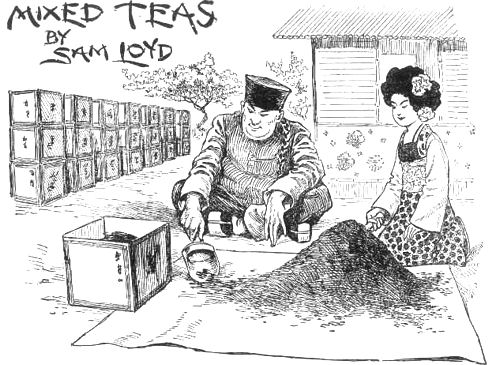



THE BLENDING OF teas with the Orientals is such an exact science that the production of certain flavors resulting from the combination of different kinds of teas is figured down to the millionth part of an ounce! And it is said that the formulas which belong to some noted growers of tea have been kept secret for hundreds of years and cannot be imitated so as to avoid detection.
Just to illustrate the accuracy and importance connected with the science of blending teas and to show the difficulty of penetrating the mystery with which the art is surrounded, attention is called to a simple puzzle based upon two blends, which suggest some idea of the complications pertaining to the mixing of half a dozen varieties.
The mixer has received two cases, perfectly square, but of different sizes, the one of green and the other of black tea, and has mixed them together so as to fill twenty-two square chests of equal size. What are the proportions of green tea to black? It looks as “childlike and bland” as a sum in simple addition which can be answered in a thousand ways, and so it can, for it merely turns upon guessing the size of two cubes Which will hold exactly as much as twenty-two smaller cubes! See! One large chest of black tea and a smaller chest of green tea. The contents being mixed together is divided into twenty-two square chests. Tell the proportions of black and green tea and you will have mastered the pretty problem of Tsehen Si.
There is a cute puzzle method for solving such puzzles of this kind, which shows that two square boxes, the one exactly 17,299 inches inside measurement, and the other 25,409 inches square on the inside, will be equal to twentytwo tea chests, exactly 9,954 inches square. So the proportions of green and black teas must have been mixed in the proportions of as 17,299 is to 25,469.
2. A Grammatical Puzzle
“Let the rich, great and noble banquet in the festal halls,
And pass the hours away, as the most thoughtless revel:
Then seek the poor man's dreary home, whose very dingy walls
Proclaim full well to all how low his rank and level. ”
Now change just one letter in one single word in the above stanza so as to make it a different word, and by that change totally alter the syntactical construction of the whole sentence, changing the moods and tenses of verbs; turning verbs into nouns; nouns into adjectives and adjectives into adverbs, etc., and so make the entire stanza take on quite a different meaning from that which it now has, and all by the substituting of one letter in a single word!
This puzzle has baffled many clever puzzlists and literary scholars as well, and yet the marvelous metamorphosis is effected by changing the first L into S, so that it will read: “Set the rich and noble banquet, etc.. etc.”
That Grammatical puzzle may be entirely changed by substituting the letter S for the L at the very beginning, so it reads: “Set the rich, etc.”
3.
Why is a New York milkman like the fish that swallowed Jonah? Because he finds a profit (prophet) in the water.
Why is it easy to break into an old mans house? Because his gait is broken and his locks are few.
What word of six letters admits of five successive elisions, leaving at each abbreviation a well-known word? Brandy—brand—bran—ran —an—a.
What word is composed of five letters, from which, if you take two, one remains? Stone.
Name two English words, one of which, being of one syllable only, shall contain more letters than the other of five syllables. Stretched — Ideality.
[Page 141]